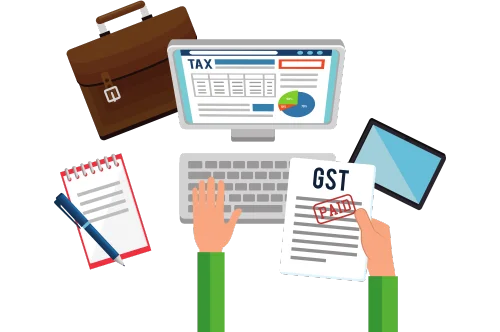Input Tax Credit (ITC) Under GST: Rules and Restrictions
Introduction
The Input Tax Credit (ITC) is a fundamental mechanism under the Goods and Services Tax (GST) system that allows businesses to reduce their tax liability by claiming credit for the taxes paid on purchases. This provision helps eliminate the cascading effect of taxes, ensuring that only the value addition is taxed at each stage of the supply chain. However, there are specific rules and restrictions businesses must follow to claim ITC.
In this blog, we will explore the rules, conditions, and restrictions associated with Input Tax Credit under GST, ensuring that you can maximize your ITC benefits while staying compliant.
What is Input Tax Credit (ITC)?
Input Tax Credit (ITC) is the credit a taxpayer receives for the tax paid on inputs, input services, and capital goods used in the course of business. It allows businesses to offset the tax they have already paid against their GST liability, thereby reducing the overall tax burden.
For example, if a business has paid ₹10,000 as GST on purchases and needs to pay ₹15,000 as GST on sales, it can claim an ITC of ₹10,000 and pay only ₹5,000 as tax.
Eligibility Conditions for Claiming Input Tax Credit
To claim Input Tax Credit, businesses must satisfy the following conditions:
- Possession of Tax Invoice – The business must have a valid tax invoice or debit note issued by a registered supplier.
- Receipt of Goods or Services – ITC can be claimed only when the goods or services for which credit is being claimed have been received.
- Tax Payment by Supplier – The supplier must have paid the tax to the government, and the details must be reflected in the GST portal.
- Filing of GST Returns – The taxpayer must have filed the required GST returns (GSTR-3B and GSTR-2B) to claim ITC.
- Use for Business Purposes – ITC can be claimed only on purchases used for business purposes and not for personal consumption.
Items on Which ITC Cannot Be Claimed (Blocked Credit)
Certain goods and services are restricted from ITC claims under Section 17(5) of the GST Act. Some of these include:
- Motor Vehicles (except when used for transport services like taxis, goods transport, or training of driving)
- Food, Beverages, and Outdoor Catering (unless used for business purposes like providing taxable services)
- Club Membership Fees
- Goods or Services for Personal Use
- Construction of Immovable Property (except for plant and machinery)
- Travel Benefits for Employees (except if required under law)
Reversal of Input Tax Credit
In certain cases, businesses must reverse their Input Tax Credit, meaning they must repay the credit claimed. The primary situations where ITC reversal is required include:
- Non-Payment to Supplier Within 180 Days – If the buyer does not pay the supplier within 180 days of the invoice date, the ITC claimed must be reversed.
- Change in Use of Goods/Services – If goods or services were used for business but later used for personal purposes, the ITC must be reversed.
- Credit Notes Issued by Supplier – If the supplier issues a credit note reducing the tax liability, the ITC must be adjusted accordingly.
Step-by-Step Process to Claim ITC Under GST
Follow these steps to claim Input Tax Credit effectively:
- Ensure the supplier has uploaded invoices in GSTR-1 – This ensures that the input tax details appear in the taxpayer’s GSTR-2B form.
- Verify the details in GSTR-2B – Cross-check the ITC details with the supplier’s filings.
- Include ITC details in GSTR-3B – Enter eligible ITC details while filing GSTR-3B to adjust against output tax liability.
- Maintain Proper Records – Keep all invoices, purchase orders, and payment receipts for audit purposes.
Common Mistakes to Avoid While Claiming ITC
Claiming Input Tax Credit can be complicated, and businesses often make errors that lead to penalties. Here are some common mistakes to avoid:
- Claiming ITC on Blocked Items – Many businesses unknowingly claim ITC on ineligible goods/services.
- Not Reconciling with GSTR-2B – If ITC is not reflected in GSTR-2B, it cannot be claimed.
- Delayed Payment to Suppliers – If payments are not made within 180 days, the ITC needs to be reversed.
- Incorrect ITC Calculations – ITC must be claimed based on the proportion of taxable business use.
- Not Keeping Proper Documentation – Incomplete records can lead to ITC rejection during audits.
Recent Updates & Changes in ITC Rules
The government frequently updates ITC rules to prevent tax evasion and improve compliance. Some recent changes include:
- Mandatory GSTR-2B Matching – ITC can be claimed only if invoices appear in GSTR-2B.
- Time Limit for Claiming ITC – ITC must be claimed by the due date of the September return of the following financial year.
- ITC Restrictions on Defaulting Suppliers – If suppliers do not file GST returns, their buyers cannot claim ITC.
Conclusion
Input Tax Credit (ITC) is an essential feature of the GST system, allowing businesses to reduce tax liability and improve cash flow. However, strict rules and restrictions apply to prevent misuse. By understanding eligibility, avoiding common mistakes, and staying updated with changes, businesses can maximize their ITC claims while ensuring compliance.
Proper record-keeping and timely filing of GST returns play a crucial role in claiming ITC smoothly. If you’re unsure about ITC claims, consulting a tax expert can help you navigate the complexities and ensure compliance with GST regulations.
Our GST Services

All E-commerce Tax services
E-commerce tax services help online sellers navigate GST registration, compliance, return filing, TCS management, tax planning, and audits, ensuring efficient tax management and legal compliance.

GST Filing
GST filing is the process of submitting tax returns to the government, detailing sales, purchases, and taxes paid or collected, ensuring compliance with GST laws.

GST Registration
GST registration is the process where businesses obtain a GSTIN from the government, allowing them to collect taxes, claim input tax credits, and comply with GST laws.





